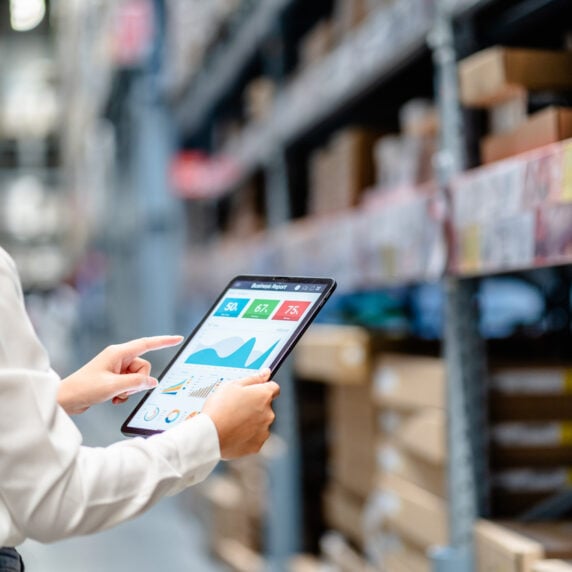Podcast: When Exceptions Are the Rule
In episode three of Be Ready for Anything, hear from Alex Achour, Senior Sales Engineer at ToolsGroup, about why S&OP processes are crucial in a crisis, how to balance automation with human expertise and what to do when machine learning fails.
Check out the video below.
Or listen and follow on Spotify.
Transcript
Katie Van Adzin: To start off with, I wanted to hear your thoughts on the importance of an established S&OP process during a crisis.
Alex Achour: That’s an interesting question, I think. Every time that I go into a new opportunity, what I find is, S&OP is not a defined process these days. You know, years ago, cloud and SaaS and hosted were buzzwords and every opportunity, you had to have cloud or hosted. What I’m finding now is everybody wants or has some form of S&OP, but they don’t have a consensus. There’s no defined solution for it. And when I ask people about “what is your S&OP process, what do you hope to achieve,” those that have an S&OP process seem to have some sort of consistency in the sense they all come armed with different data. And the term that I get a lot when describing the processes, that it’s a gripe fest. People have different motives of what they want to accomplish. Is it a forecast consensus, a production consensus. You know, what are they trying to accomplish? And what I find is there’s, when it is defined as such, they usually don’t have a solid foundation. So having a foundation of data that people share and have trust in is how you start the process. If you have the same data and every team has the same data, then what you’re doing is you’re providing a different view of your perspective. Marketing’s view, sales view, different things like that. So I think it’s a very important process because everybody comes to the table armed with, you know, their view and field and ability to provide value. But if they all come with different views, you’re just butting heads. So I think this is a good time, number one, to understand what is S&OP, and it’s not a predefined, one size fits all. It’s what do you want to accomplish in your organization? But start with the same view. I think that’s what’s really important. And now more than ever, people like finance, the budget, sales, you know, where can I provide extra value? You need to not only have the data, but you need to understand where the problem areas are. Just coming in to do a consensus without understanding, “Hey, our budget is suffering. Where are the areas that are suffering, and how can we approach that? Marketing, can you give us something? Sales, what can you do about this?” That’s where I think you can apply a lot of value to it. And you know, as we’ll talk about a little bit later on today, the human interaction can really come into play in a crisis.
Katie Van Adzin: Yeah, touching on that since the Covid crisis began, there’s been a lot of discussion as to the ideal balance between human planners and automated solutions. What would you describe as the optimal balance between those two?
Alex Achour: You know, let’s forget Covid for a moment here. You know, why are humans important today? I mean, obviously humans are important. I’m not dismissing that, but humans come into play in a different way than machines ever could. And it’s understanding and learning. It’s the ability to, you know, you touch something hot, you learn that it’s hot, don’t touch it again. It’s the same thing. You learn that certain seasons, Thanksgiving, you learn that customers have specific promotions or cycles. That’s a human type of thing. And where machines come in is the repetitive tasks, the data-intensive tasks. If I’ve got a lot of data coming at me, all these different promotions and different markets, I know a promotions going on. I just don’t really have in my mind, Cincinnati versus Miami. You know, I might have an idea, but having a pattern and repetitive tasks, machines are really good at identifying that. And a lot of people think systems should work like humans. And that’s just not true. If you think of a human, you know, pen and paper and writing, what does a machine do? Typing. It’s a different process. It’s a different form. Now you have the ability to scan data and such. So machines should be an extension of the people. And one of the ways that you can extend it as I have this phrase that I like to call “chase the PO.” It’s the way a lot of organizations work right now. Their problem is late POs. I don’t have product where I expect it. So I have to go chase those things. And the way you do it is you start examining all of your POs. Well, that’s an exception that’s happening late, okay? You really want to understand the effect ahead of time. And machines are really good at analyzing some of these things. Number one, do I have the proper amount on order for things that are happening? And number two, is the timing correct? The last thing about machines and automation is they need to be unobtrusive. One of the reasons that people don’t like a lot of the systems is it’s so different than the way that they’re doing things. They need to understand that the system needs to augment a way a human works. So when planning on these things, it’s not a rip and tear. The humans understand that. As I mentioned, their markets, their demographics, their products, a seasoned individual, a strong individual will understand that, and the system should automate as much as it can and rise to the top what a human really needs to pay attention and provide guidance.
Katie Van Adzin: That makes sense. And to support that, what should companies do to be sure that they have the data and maturity that would enable an effective balance between automation and human intervention?
Alex Achour: Yeah, and that’s kind of a fun thing. I’ve gone into a lot of companies, okay? And what I often find is people are trying to solve an effect and not a problem, you know, a symptom and not a cause. I like to say you’re blaming the last domino, okay, when things fall down. As I mentioned, the chasing the PO. The PO can often be due to patterns of change, okay? For the consumer. It’s not the POs fault, okay? If people are buying more toilet paper, more cleanser or something. It’s not the vendor’s fault if you order based on certain behavior. And if you chase the PO, you’re way too late, because the behavior has changed. So you need to understand ahead of time, as quickly as possible, those buying patterns, things that are happening in the market.
Or on the other side of that, if you’re chasing the PO because a vendor is late, then there’s different things associated with that. Why is the vendor late? Is there some seasonality concerns? Are there promotions going on? Are they just poor at enforcing their delivery schedules? All of those can be measured. All of those have metrics tied to them and understanding the effect means that you can do something about it before and after. If you have to stock extra product because a vendor is consistently late, you need to understand and build that into your buying patterns and you need to pass that cost along. So having, the other side of this is having a coherent flow of data. One of the things on data maturity, when I go into an organization is we’ll go into a room and do a whiteboard. I remember with one tier, one organization that I worked with has 8,000 stores, we spent three days on this whiteboard. And what you have to do is you have to understand the flow of data in, data related to items, vendors, consumers, the POS behavior, your warehouse behavior, finance, HR. So if you can map this flow, what often happens is I’ll find that there’s multiple sources of the truth. Again, back to that S&OP process. Having a consistency of data that everybody can trust and understanding the flow of that data is very important to achieving data maturity, okay? So you can’t have several master data management systems. You have to have just one, right? And that comes, and I know that’s a very difficult thing when it comes to items and vendors and stores and things like that. But having that data maturity allows you to be able to automate with confidence. ‘Cause if things are being updated here and here, where’s your confidence, how do you bring those together? And that’s where things tend to fall apart.
So I would say number one, map things out, and number two, don’t chase the effect, find the cause. And when you map out your entire data flow, you’ll often find that changes in consumer behavior patterns could be found at the POS. They can be found at your inventory counts. They can be found much earlier in the process. They can even be found in social media activity, if you’re doing something like machine learning and such.
Katie Van Adzin: Speaking of machine learning, what kinds of shortcomings have you seen in machine learning and AI systems since the pandemic began?
Alex Achour: Well, you remember when I talked about S&OP and people don’t really understand sometimes what S&OP is? Machine learning is that way, too. Machine learning is an interesting, it’s a buzzword. Not a single vendor out there these days seems to sell anything without saying that they have machine learning. And, you know, AI was the big thing before. AI, frankly is, it’s just programs and data, all right? So, machines can’t think for themselves, they don’t have brains like we do. A machine learning engine thinks in ways that they’re taught and that’s formulas.
Machine learning is a little bit different. They’re basically, there’s three steps to machine learning. And the first one is supervised learning and these are guided models or set algorithms. In replenishment forecasting, the big ones are Holt-Winters and exponential smoothing. Well,guess what? Exponential smoothing was created in the 1600s, okay? It was conceptually thought of in the 1600s, it was leveraged in the 1800s in retail organizations because it’s a mathematical formula and Holt-Winters, which is the predominant method of forecasting was created in 1957. So over 50 years ago. I would venture to say, 90% of all forecasting systems use those. And they’re calling that these days machine learning. I guess technically they are because they’re supervised. I have a formula, I put data in, I get results, I get variability around those results, okay? And I’ve done it through a machine.
But the second step, and this is really where a lot of companies are going is unsupervised learning. If you think about like a tic-tac-toe board, okay? And the different squares and the tic-tac-toe board, a lot of people will say, “Hey, I’m trying to find out where this data falls “and define it into these nine boxes.” Well, unsupervised learning is actually looking at, it’s not the nine boxes. It’s how does it flow through? Maybe I have something in box one, five and eight, okay? And I have several patterns that flow through it. And another one that flows around this way, and it’s multidimensional. So this unsupervised learning is the ability to not just bucket something into a simplistic formula or most common formula, but basically find, you know, how it flows.
And then there’s something that the last step of machine learning is self-learning. And very few companies that claim to have machine learning really have self-learning and self-learning is, it’s not about the board, it’s about the player. It’s about the interaction. It’s about time of day. It’s about, what else does the player play? So it, what I’m trying to say is, it’s about more than just this, it’s about anything else I can think associated around that. So the more data you can throw at a true machine learning engine, the smarter it’s going to be. So these companies, anybody that tells you have machine learning, challenge them, okay? What are you doing? Is this a best fit basket algorithm? Or do you have the ability to do this unsupervised or the self-learning? How much data can I put into your machine learning engine that it can find relevance and understand that? And the last system of this on the self-learning is it needs to grade itself, okay? A machine learning engine needs to understand, I’ve got a lot of data, I can create these patterns, but are the patterns relevant to the real world? Do they apply benefit?
And the last thing on machine learning is machine learning should be separate from programs, okay? In the same way, your brain is separate from your body. And there’s a number of different reasons. One of them is the rate of change in machine learning right now is crazy. There’s so much going on. So there’s this concept of leveraging something, and this is just an example, it’s not, you know, the rule, but a Docker-based packaging, okay? So an IT person’ll know that term, a business person may not. But the idea is I’m segmenting my programs from my machine learning engine. And what that does is it allows my programmers to program away and do whatever enhancements. And it allows the data scientists to apply more smarts, more smarts, more smarts. And I don’t have to re-engineer the entire thing. Anybody who embeds their machine learning in their programs is asking you to update every time that there’s some significant change. So understanding these concepts, challenge the people, don’t just take the buzzword. Challenge them so that you understand what it is.
And in regards to pandemic, well, guess what? Machines aren’t perfect. Machine learning isn’t perfect. If we’ve ever seen a time of exceptions, it’s now. Remember before, when I talked about the machine should be unobtrusive? Well, the concept of machine learning is handle what you can and ask for help when you can’t. And during Covid, this now more than ever, these exceptions are going to rise up, and I need humans more than ever now to understand those exceptions. But I also need the machine learning to understand, once things return to normal, this year’s worth of pattern should not be leveraged in next year. I need to understand, you know, toilet paper and cleaning supplies, and guess what? People aren’t buying formal shirts this year. You know, so understanding the ups and downs, smoothing those processes out for next year is very important. So that’s, that’s my long-winded answer.
Katie Van Adzin: No, that’s great. And building off of that, my final question is, how would you advise companies to optimize their automated system to avoid some of these pitfalls?
Alex Achour: Yeah, and this goes back to the white boarding exercise that I like to do with organizations that truly want to change, you know, or transform. Understand the data that you have. You have to understand what you have and how it flows. Really need a good understanding of that. How’s it used? And then, once you understand your network, now you can see what can be automated, okay? Don’t automate at the very end, the last domino. Don’t automate, “Hey, we’re out of stock and our problem is the PO.” No, you’re out of stock because of vendor performance, you’re out of stock because of consumer behavior, you’re out of stock, you know, for a whole different reasons, consumer behavior, pattern changes, you’re out of stock because of promotions. You know, one of the interesting things about promotions is, 40% of all product goes out of stock because of a promotion. You know, it’s a very challenging thing to do. So understanding the underlying causes of the effect and attack the causes.
And the other side of this is, if you’re going to transform an organization and automate as much as you can, you need to create cost models. Automation for the sake of automation is not very smart, especially right now, especially right now when you really have to focus on what’s important because it’s a very different world right now. Some companies are very challenged for money. Other companies are swimming in it. I’m working with some companies in the medical field that, you know, they can’t keep up with demand. And in the retail world, it’s a challenge to get people in. So understanding the cost models, where things make financial sense and how, then you can prioritize it.
And the last thing that I would say on this is, you know, I have worked with over a thousand companies in my 28 years doing this and I have seen companies fail and I’ve seen companies do exceptionally well. And I can really trace that down to people. It’s not just processes, it’s people. Having a strong leadership involvement in any of these projects. I’ve seen companies that just sign on to a transformation, the leaders just sorta disappear, they don’t have any strong project management and it flounders and it just goes away. I could name names, but I’m not going to. And I’ve seen some other companies where the leaders come in, they set timetables, they measure those timetables, they enforce those timetables and they reward those timetables. Those companies inevitably do well. I mean, so it’s not all about automation. It’s about having the proper people in place, understanding where your value is and tracking that to success. That’s my two cents.
Katie Van Adzin: Well, thank you very much for all of these insights today. It’s really helpful.
Alex Achour: Sure, anytime.
Katie Van Adzin: Take care!






